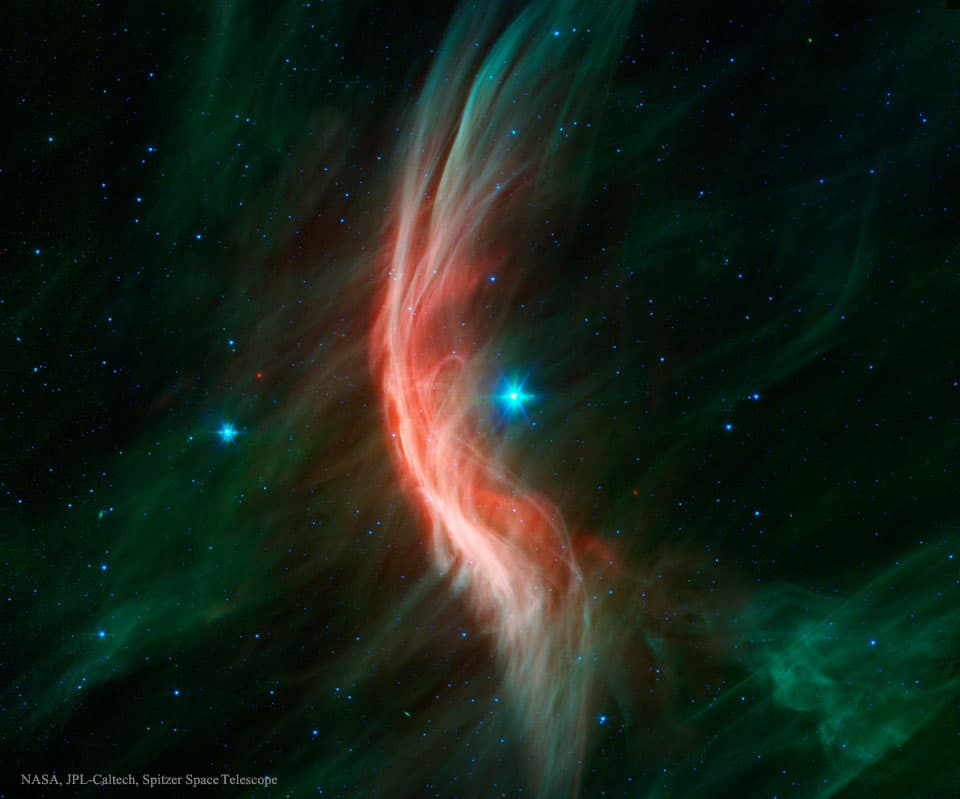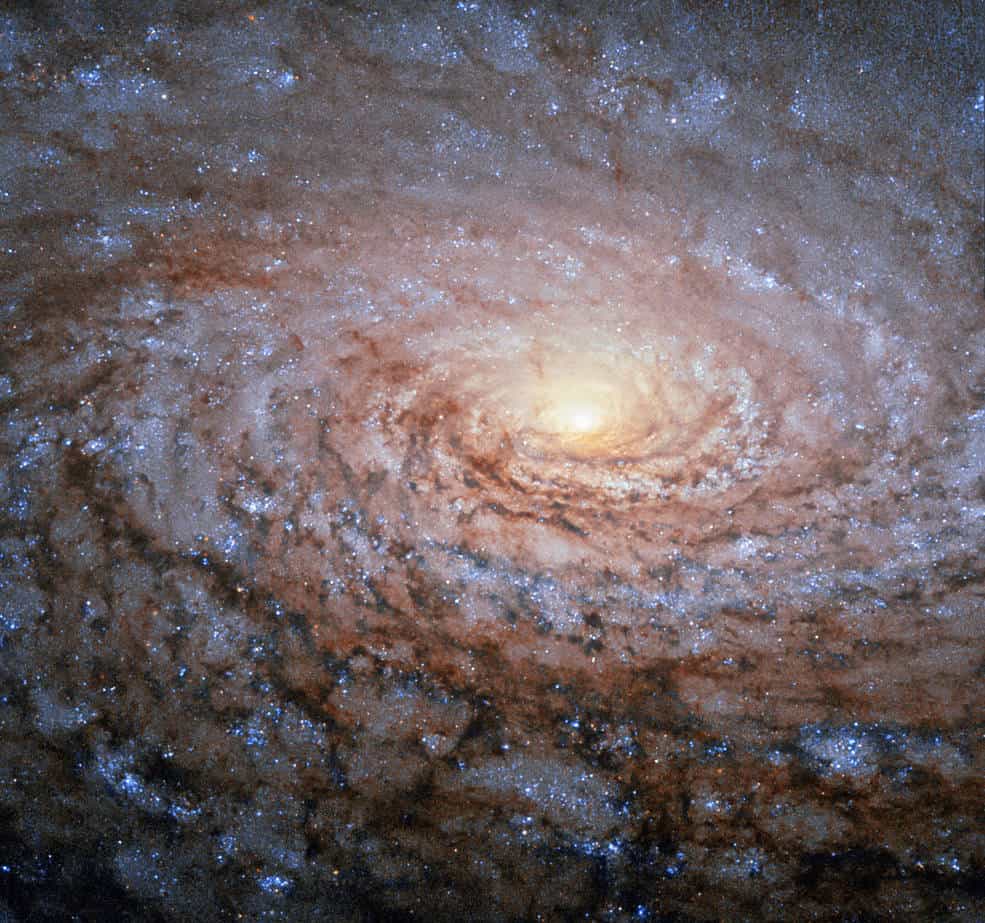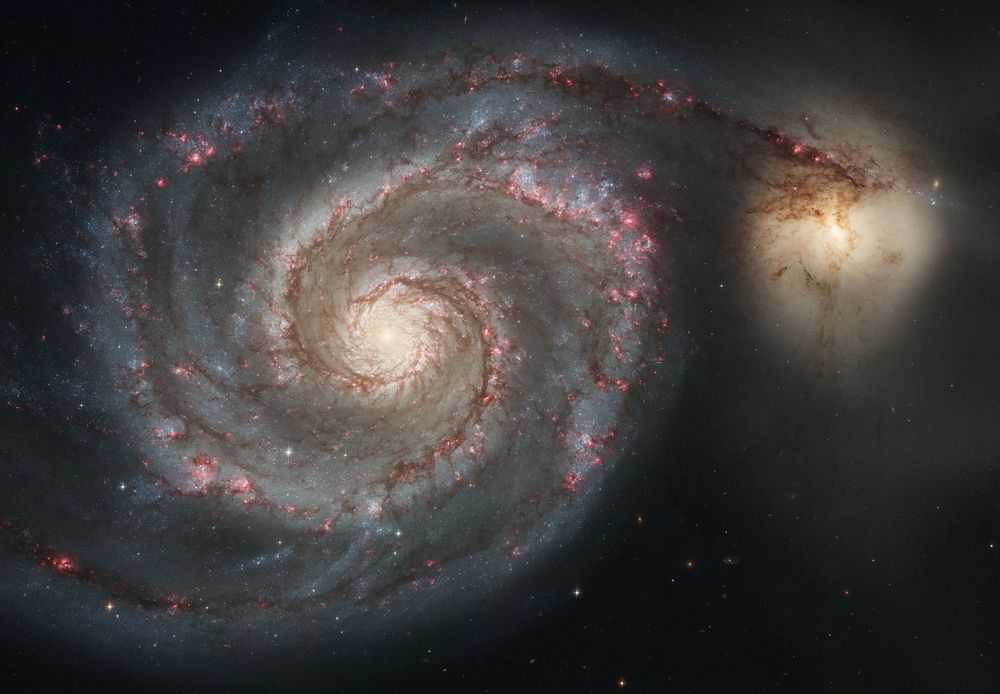Blog
Zeta Ophiuchi produces the arcing interstellar bow wave or bow shock seen in this stunning infrared portrait. In the false-color view, bluish Zeta Oph, a star about 20 times more massive than the Sun, lies near the center of the frame, moving toward the left at 24 kilometers per second. Its strong stellar wind precedes it, compressing and heating the dusty interstellar materialand shaping the curved shock front. What set this star in motion? Zeta Oph was likely once a member of a binary star system, its companion star was more massive and hence shorter lived. When the companion exploded as a supernova catastrophically losing mass, Zeta Oph was flung out of the system. About 460 light-years away, Zeta Oph is 65,000 times more luminous than the Sun and would be one of the brighter stars in the sky if it weren’t surrounded by obscuring dust. The image spans about 1.5 degrees or 12 light-years at the estimated distance of Zeta Ophiuchi. Last week, NASA placed the Spitzer Space Telescope in safe mode, ending its 16 successful years of studying our universe.

Graham William Nash OBE (born 2 February 1942) is a British-American singer-songwriter and musician. Nash is known for his light tenor voice and for his songwriting contributions as a member of the English pop/rock group the Hollies and the folk-rock supergroup Crosby, Stills & Nash. Nash became an American citizen on 14 August 1978 and holds dual citizenship of the United Kingdom and the United States.
Nash is a photography collector and a published photographer. He was inducted into the Rock and Roll Hall of Fame as a member of Crosby, Stills & Nash in 1997 and as a member of the Hollies in 2010.
Nash was appointed an Officer of the Order of the British Empire (OBE) in the 2010 Birthday Honours List for services to music and to charity.
Nash holds four honorary doctorates, including one from New York Institute of Technology, one in Music from the University of Salford in 2011 and his latest Doctorate in Fine Arts from Lesley University in Cambridge, Massachusetts.
more...Stan Getz (born Stanley Gayetski; February 2, 1927 – June 6, 1991) was an American jazz saxophonist. Playing primarily the tenor saxophone, Getz was known as “The Sound” because of his warm, lyrical tone, his prime influence being the wispy, mellow timbre of his idol, Lester Young. Coming to prominence in the late 1940s with Woody Herman‘s big band, Getz is described by critic Scott Yanow as “one of the all-time great tenor saxophonists”. Getz performed in bebop and cool jazz groups. Influenced by João Gilberto and Antônio Carlos Jobim, he popularized bossa nova in America with the hit single “The Girl from Ipanema” (1964).
Getz was born Stanley Gayetski on February 2, 1927, at St. Vincent’s Hospital in Philadelphia, Pennsylvania, United States. Getz’s father Al was born in Mile End, London, in 1904, while his mother Goldie (née Yampolsky) was born in Philadelphia in 1907. His paternal grandparents Harris and Beckie Gayetski were originally from the Kiev area of the Russian Empire (now Ukraine) but had migrated to escapee the pogroms in the Russian Empire to Whitechapel, in the East End of London. There, they owned the Harris Tailor Shop at 52 Oxford Street for more than 13 years. In 1913, Harris and Beckie emigrated to the United States with their three sons Al, Phil, and Ben, following their son Louis Gayetski who had emigrated to the US the year before.
more...Edward Hammond Boatner Jr. (February 2, 1924 – July 22, 1982), known professionally as Sonny Stitt, was an American jazz saxophonist of the bebop/hard bop idiom. Known for his warm tone, he was one of the best-documented saxophonists of his generation, recording more than 100 albums. He was nicknamed the “Lone Wolf” by jazz critic Dan Morgenstern because of his relentless touring and devotion to jazz. Stitt was sometimes viewed as a Charlie Parker mimic, especially earlier in his career, but gradually came to develop his own sound and style, particularly when performing on tenor saxophone.
Edward Hammond Boatner, Jr. was born in Boston, Massachusetts and grew up in Saginaw, Michigan. He had a musical background: his father, Edward Boatner, was a baritone singer, composer, and college music professor; his brother was a classically trained pianist, and his mother was a piano teacher. He was given up for adoption in 1924 by his father and adopted by the Stitt family in Saginaw. He later began calling himself “Sonny”. While in high school in Saginaw, he played in the Len Francke Band, a local popular swing band.
In 1943, Stitt met Charlie Parker. As he often recalled, the two men had similar styles. Parker is alleged to have remarked, “Well, I’ll be damned, you sound just like me”, to which Stitt responded, “Well, I can’t help the way I sound. It’s the only way I know how to play.” Kenny Clarke said of Stitt, “Even if there had not been a Bird, there would have been a Sonny Stitt.
more...Star formation is one of the most important processes in shaping the universe. In addition to birthing new stars, it gives rise to planetary systems and plays a pivotal role in the evolution of galaxies. Yet there is still much that astronomers do not understand about this fundamental process. The driving force behind star formation is particularly unclear for a type of galaxy called a flocculent spiral. Unlike grand-design spiral galaxies, flocculent spiral galaxies do not have well defined spiral arms. Instead, they appear to have many discontinuous arms.
M63, also known as the Sunflower galaxy, is one such flocculent spiral galaxy. Although it only has two arms, many appear to be winding around its yellow core in this image captured by Hubble. The arms shine with the radiation from recently formed blue stars and can be more clearly seen in infrared observations. By imaging flocculent spiral galaxies like M63, astronomers hope to gain a better understanding of how stars form in such systems.
The Sunflower galaxy was discovered in 1779 by the French astronomer Pierre Méchain and was the first of 24 objects that Méchain would contribute to Charles Messier’s catalog. The galaxy is located roughly 27 million light-years from Earth in the constellation Canes Venatici. It has an apparent magnitude of 9.3 and appears as a faint patch of light in small telescopes. The best time to observe M63 is during May.

Joshua Redman (born February 1, 1969) is an American jazz saxophonist and composer.
In 1991, he won the Thelonious Monk International Jazz Saxophone Competition.
Joshua Redman was born in Berkeley, California, to jazz saxophonist Dewey Redman and dancer and librarian Renee Shedroff. He is Jewish.He was exposed to many kinds of music at the Center for World Music in Berkeley, where his mother studied South Indian dance. Some of his earliest lessons in music and improvisation were on recorder with gamelan player Jody Diamond. He was exposed at an early age to a variety of musics and instruments and began playing clarinet at age nine before switching to what became his primary instrument, the tenor saxophone, one year later. Redman cites John Coltrane, Ornette Coleman, Cannonball Adderley, his father Dewey Redman, as well as the Beatles, Aretha Franklin, the Temptations, Earth, Wind and Fire, Prince, the Police and Led Zeppelin as musical influences.
more...Joseph Leslie Sample (February 1, 1939 – September 12, 2014) was an American pianist, keyboard player, and composer. He was one of the founding members of the Jazz Crusaders, the band which became simply the Crusaders in 1971, and remained a part of the group until its final album in 1991 (not including the 2003 reunion album Rural Renewal).
Beginning in the 1970s, he enjoyed a successful solo career and guested on many recordings by other performers and groups, including Miles Davis, George Benson, Jimmy Witherspoon, B. B. King, Eric Clapton, Steely Dan, Joni Mitchell, Anita Baker, and the Supremes. Sample incorporated jazz, gospel, blues, Latin, and classical forms into his music.
Sample was born in Houston, Texas, on February 1, 1939. Sample began to play the piano at age 5. He was a student of the organist and pianist Curtis Mayo.
In high school in the 1950s, Sample teamed up with friends saxophonist Wilton Felder and drummer “Stix” Hooper to form a group called the Swingsters. While studying piano at Texas Southern University, Sample met and added trombonist Wayne Henderson and several other players to the Swingsters, which became the Modern Jazz Sextet and then the Jazz Crusaders, in emulation of one of the leading progressive jazz bands of the day, Art Blakey‘s Jazz Messengers. Sample never took a degree from the university; instead, in 1960, he and the Jazz Crusaders made the move from Houston to Los Angeles. He was a member of Phi Beta Sigma fraternity.
more...Sadao Watanabe (渡辺 貞夫, Watanabe Sadao, born February 1, 1933) is a Japanese jazz musician who plays alto saxophone, sopranino saxophone, and flute. He is known for his bossa nova recordings, although his work encompasses many styles with collaborations from musicians all over the world. He has had over ten albums reach the top 50 Billboard charts and two within the top 10. He has also had numerous albums reach number one on the jazz charts. Among his awards are the Order of the Rising Sun, the imperial medal of honor for contribution to the arts, and the Fumio Nanri award.
Born in Utsunomiya, Japan, Sadao first began learning music at the age of 18 and started performing professionally in 1953. By 1958 he had performed with leading musicians and quartets. In 1962 he left Japan to study at Berklee College of Music in Boston. In 1995 the college awarded him an honorary doctorate degree for his contributions to music. In addition to his musical career, Watanabe has published six photography books in Japan.
more...“Baby Face” Leroy Foster (February 1, 1923 – May 26, 1958) was an American blues singer, drummer and guitarist, active in Chicago from the mid-1940s until the late 1950s. He was a significant figure in the development of the postwar electric Chicago blues sound, notably as a member of the Muddy Waters band during its formative years.
Foster was born in Algoma, Mississippi. He moved to Chicago in the mid-1940s and by 1946 was working with the pianist Sunnyland Slim and the harmonica player John Lee “Sonny Boy” Williamson. He was introduced to the singer and guitarist Muddy Waters by an acquaintance Waters met at a recording session in 1946. Foster was soon playing guitar and drums in Waters’s band, along with the guitar and harmonica player Jimmy Rogers. The band was later joined by Little Walter on harmonica. Calling themselves the Headhunters, the trio was known for going from club to club and “cutting” (i.e., engaging in musical duels with) other bands.
more...https://www.youtube.com/watch?v=LOS0kA_O6IQ
more...NGC 5195 (also known as Messier 51b or M51b) is a dwarf galaxy that is interacting with the Whirlpool Galaxy (also known as M51a or NGC 5194). Both galaxies are located approximately 25 million light-years away in the constellation Canes Venatici. Together, the two galaxies are one of the most famous interacting galaxy pairs. NGC 5195 was discovered by Pierre Méchain on March 20, 1781.
NGC 5195 and the Whirlpool Galaxy compose one of the most noted interacting galaxy pairs in astronomy. The two galaxies are listed in the Atlas of Peculiar Galaxies as one of several prominent examples of a spiral galaxy with a companion galaxy. The system was also the subject of very early theoretical investigations into galaxy interactions. The two galaxies are connected by a dust-rich tidal bridge. The dust in this tidal bridge can be seen silhouetted against the center of NGC 5195. This demonstrates that NGC 5195 appears to lie behind the Whirlpool Galaxy. The encounter has significantly enhanced the spiral structure of M51.

Philip Glass (born January 31, 1937) is an American composer and pianist. He is widely regarded as one of the most influential composers of the late 20th century. His work has been associated with the minimalist school of composition. Glass describes himself as a composer of “music with repetitive structures”, which he has helped evolve stylistically.
Franz Peter Schubert (German: [ˈfʁant͡s ˈpeːtɐ ˈʃuːbɐt]; 31 January 1797 – 19 November 1828) was an Austrian composer of the late Classicaland early Romantic eras. Despite his short lifetime, Schubert left behind a vast oeuvre, including more than 600 secular vocal works (mainly lieder), seven complete symphonies, sacred music, operas, incidental music and a large body of piano and chamber music. His major works include the Piano Quintet in A major, D. 667 (Trout Quintet), the Symphony No. 8 in B minor, D. 759 (Unfinished Symphony), the ”Great” Symphony No. 9 in C major, D. 944, the three last piano sonatas (D. 958–960), the opera Fierrabras (D. 796), the incidental music to the play Rosamunde (D. 797), and the song cycles Die schöne Müllerin (D. 795) and Winterreise (D. 911).
Born in the Himmelpfortgrund suburb of Vienna, Schubert’s uncommon gifts for music were evident from an early age. His father gave him his first violin lessons and his older brother gave him piano lessons, but Schubert soon exceeded their abilities.
Roosevelt Sykes (January 31, 1906 – July 17, 1983) was an American blues musician, also known as “The Honeydripper“.
Sykes was born in Elmar, Arkansas, and grew up near Helena. At age 15, he went on the road playing piano in a barrelhouse style of blues. Like many bluesmen of his time, he travelled around playing to all-male audiences in sawmill, turpentine and levee camps along the Mississippi River, sometimes in a duo with Big Joe Williams, gathering a repertoire of raw, sexually explicit material. His wanderings eventually brought him to St. Louis, Missouri, where he met St. Louis Jimmy Oden, the writer of the blues standard “Goin’ Down Slow“.
In 1929 he was spotted by a talent scout and sent to New York City to record for Okeh Records. His first release was “44 Blues” which became a blues standard and his signature song. He soon began recording for different labels under various names, including Easy Papa Johnson, Dobby Bragg, and Willie Kelly (for Victor Records from 1930 to 1933). During this period he befriended another blues musician, the singer Charlie “Specks” McFadden, and accompanied him on half of the McFadden’s recordings. After he and Oden moved to Chicago, Sykes found his first period of fame when he signed a contract with Decca Records in 1934. In 1943, he signed with Bluebird Records and recorded with the Honeydrippers. Sykes and Oden continued their musical friendship into the 1960s.
In Chicago, Sykes began to display an increasing urbanity in his songwriting, using an eight-bar blues pop gospel structure instead of the traditional twelve-bar blues. Despite the growing urbanity of his style, he gradually became less competitive in the post–World War II music scene. After his contract with RCA Victor expired, he recorded for smaller labels, such as United, until his opportunities ran out in the mid-1950s.
Sykes left Chicago in 1954 for New Orleans as electric blues was taking over the Chicago blues clubs. When he returned to recording in the 1960s, it was for labels such as Delmark, Bluesville, Storyville and Folkways, which were documenting the quickly passing blues history. He lived out his final years in New Orleans, where he died from a heart attack on July 17, 1983.
https://www.youtube.com/watch?v=3ti2gQ14lJY
more...More Posts
- Buddy Holly
- World Music Yannis Kaklis
- Daily Roots King Tubby
- Rhythm Roots Workshop @ Memory Café Jewish Family and Children’s Service
- Cosmos WR 136
- Roger Waters
- Charles Moffett
- Eddie Duran
- Jimmy Reed
- World Drumming Babatunde Olatunji
- Daily Roots Phil Pratt and the Sunshot Band
- Cosmos M51
- Buddy Miles
- Sunnyland Slim
- John Cage
- World Music Tsitsino Dingashvili
- Daily Roots The Aggrovators
- Happy Labor Day 2023
- Cosmos ELT ESO Sun
- Darius Milhaud